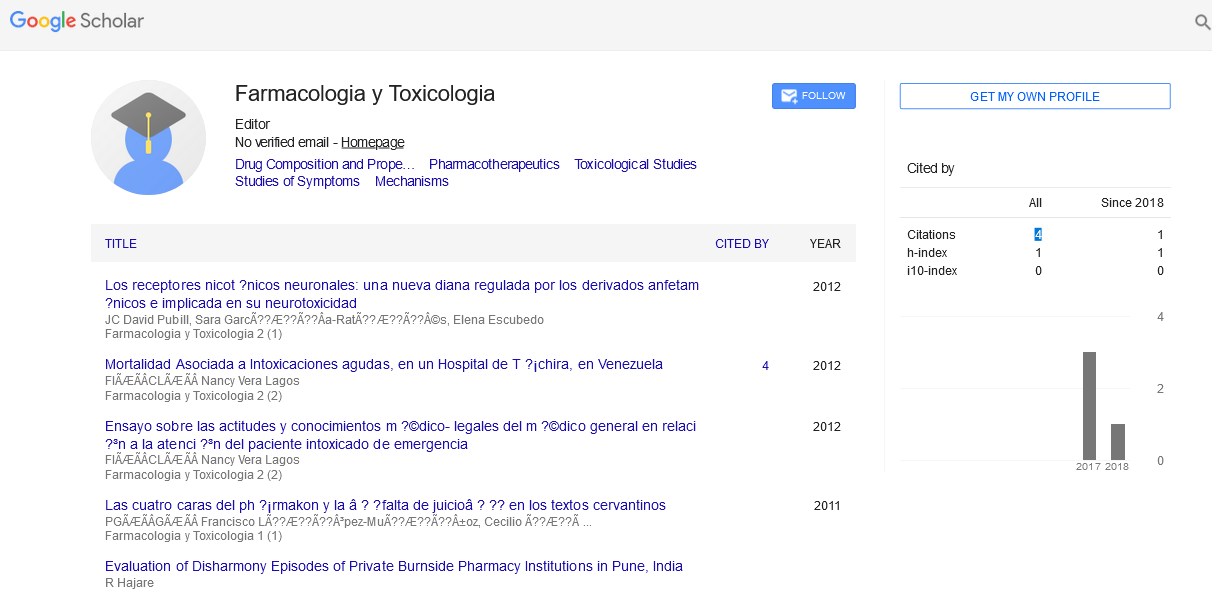Perspective - (2024) Volume 14, Issue 4
In Vitro Assays in Toxicology: A Comprehensive Overview
Frederik Staikowsky*
Department of Toxicology, University of Regeri, Malang, Indonesia
*Correspondence:
Frederik Staikowsky, Department of Toxicology, University of Regeri, Malang,
Indonesia,
Email:
Received: 02-Jul-2024, Manuscript No. IPFT-24-14973;
Editor assigned: 05-Jul-2024, Pre QC No. IPFT-24-14973 (PQ);
Reviewed: 19-Jul-2024, QC No. IPFT-24-14973;
Revised: 01-Aug-2024, Manuscript No. IPFT-24-14973 (R);
Published:
29-Aug-2024
Introduction
In the realm of toxicology, where understanding the effects of
chemicals and substances on living organisms is paramount, in
vitro assays play a pivotal role. These assays, conducted outside
of a living organism in controlled laboratory conditions, provide
crucial insights into toxicity mechanisms, allowing researchers to
assess potential risks to human health and the environment. This
article explores the significance, methodologies, advancements
and challenges associated with in vitro assays in toxicology.
Description
Signi icance of in vitro assays
In vitro assays serve as indispensable tools in toxicological
studies for several reasons. Firstly, they facilitate the screening
of numerous chemicals quickly and cost-effectively compared to
traditional in vivo studies, which involve live animals and are
often more time-consuming and ethically complex. This
efficiency is particularly beneficial when testing large numbers
of substances for potential toxicity, allowing researchers to
prioritize further investigation based on initial findings.
Moreover, in vitro assays provide insights into the
mechanisms of toxicity at the cellular and molecular levels. By
examining how substances interact with cellular components or
biochemical pathways, researchers can identify specific modes
of action, such as oxidative stress, genotoxicity or disruption of
cellular signaling, which are crucial for understanding the
potential health risks posed by these substances.
Methodologies of in vitro assays
In vitro assays encompass a diverse range of methodologies
tailored to assess different aspects of toxicity. Common assays
include cytotoxicity assays, which measure the effects of
substances on cell viability and proliferation. These assays often
utilize techniques such as the MTT (3-(4,5-dimethylthiazol-2-
yl)-2,5-diphenyltetrazolium bromide) assay or the LDH (lactate
dehydrogenase) release assay to quantify cellular damage or
death.
Another important category is genotoxicity assays, which
evaluate the potential of substances to cause damage to DNA, a
critical indicator of carcinogenicity. Examples of genotoxicity assays include the ames test, which uses bacteria to detect
mutations induced by chemical exposure and the micronucleus
assay, which identifies chromosomal damage in mammalian
cells.
Advancements in in vitro assays
Recent advancements in technology and methodology have
significantly enhanced the capabilities and relevance of in vitro assays in toxicology. One notable advancement is the
incorporation of High Throughput Screening (HTS) techniques,
which allow researchers to rapidly test large numbers of
substances against specific biological targets or endpoints. HTS
platforms utilize automation and robotics to increase assay
throughput, thereby accelerating the pace of toxicity testing and
improving efficiency.
Moreover, the development of advanced cell culture models
has diversified the types of in vitro assays available. For instance,
three-Dimensional (3D) cell culture systems better mimic the
complexity of tissues and organs compared to traditional
monolayer cultures, offering more physiologically relevant
models for toxicity testing. Organ-on-chip technologies, which
simulate the microenvironment and functionality of human
organs, further enhance the predictive value of in vitro assays by
replicating tissue-level responses to chemical exposure.
In addition to technological advancements, there has been
progress in the incorporation of computational models and
predictive toxicology approaches in conjunction with in vitro assays. Computational models, such as Quantitative Structure-
Activity Relationship (QSAR) models and Physiologically Based
Pharmacokinetic (PBPK) models, help predict the toxicity of
chemicals based on their structural properties and biological
behavior. By integrating experimental data from in vitro assays
with computational predictions, researchers can prioritize
chemicals for further testing or regulatory assessment, thereby
optimizing resource allocation and decision-making in
toxicological studies.
Challenges and limitations
Despite their advantages, in vitro assays face several
challenges and limitations that impact their reliability and
applicability. One significant challenge is the complexity of
replicating the dynamic interactions and systemic effects
observed in whole organisms within in vitro systems. Cells
cultured in a dish may not fully capture the physiological responses and intercellular communications that occur in living
organisms, potentially leading to discrepancies between in vitro and in vivo outcomes.
Furthermore, the standardization and validation of in vitro assays remain crucial for ensuring reproducibility and regulatory
acceptance. Variations in experimental protocols, cell lines,
culture conditions and endpoint measurements can influence
assay results, highlighting the need for standardized procedures
and quality control measures across laboratories.
Ethical considerations also play a role, as while in vitro assays
reduce the use of live animals in toxicological testing, ethical
concerns persist regarding the use of human-derived cells or
tissues and the potential implications for human health.
Future directions
Looking ahead, ongoing research efforts are focused on
addressing these challenges and advancing the field of in vitro toxicology. Improving the physiological relevance of cell culture models through the development of more sophisticated
organotypic and multi-organ systems holds promise for
enhancing the predictive accuracy of in vitro assays. Integrating
omics technologies, such as genomics, proteomics and
metabolomics, with in vitro testing can provide comprehensive
insights into molecular pathways and biomarkers of toxicity,
further enhancing the mechanistic understanding of chemical
hazards.
Conclusion
In vitro assays are indispensable tools in modern toxicology,
offering efficient, mechanistically informative methods for
assessing chemical hazards to human health and the
environment. While challenges remain, advancements in
technology, methodology and interdisciplinary collaboration
continue to drive innovation in the field, paving the way for safer
chemicals and improved regulatory decision-making.
Citation: Staikowsky F (2024) In Vitro Assays in Toxicology: A Comprehensive Overview. Farmacologia Toxicologia, Vol.14 No.4: 036





